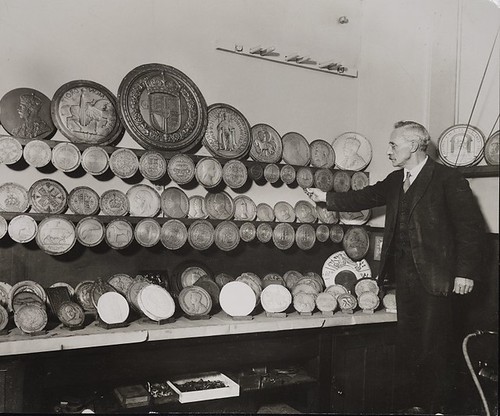
PREV ARTICLE
NEXT ARTICLE
FULL ISSUE
PREV FULL ISSUE
VOCABULARY TERMS: DIESHELL, EPOXYDick Johnson submitted these entries from his Encyclopedia of Coin and Medal Terminology. Thanks. -Editor
 Galvano dieshells used for coins and medals struck by Britain's Tower Mint Dieshell. A metal pattern from which a die is cut. Dieshells are made from plaster patterns (although wood or other media patterns have been used) by the electrogalvanic process forming a negative copper GALVANO. All coins and art medals were made with metal dieshells for most of the 20th century. Historically these were first made from metal FOUNDRY CASTS. These were replaced by electrogalavaic patterns with the development of this technology and adopted by mints in the 1850s for greater fidelity of detail. Dieshells must be negative to cut a die (also negative). If the pattern is positive it will cut a hub and is called a HUBSHELL. The dieshell is mounted on the die-engraving pantograph as the pattern to reduce the design and simultaneously cut the die. The dieshell usually is made with about a 1-inch FLANGE around its outer circumference that is necessary to mount it with clamps on the pantograph. Recently metal dieshells have been replaced with epoxy patterns. See EPOXY. See also ELECTROFORMING for how a galvano dieshell is made; see PANTOGRAPH, DIE-ENGRAVING PANTOGRAPH for how it is mounted and employed to cut the die. Epoxy. A two-part resin composition with two uses in the medallic field: as a pattern for cutting a die and also as an adhesive for mounting medallic objects. For patterns the resin is mixed with a hardener and formed as a mold from a plaster model properly treated with a release agent. It sets to a very hard, permanent surface used in the coin and medal field as patterns for die reductions. A positive plaster model will result in the negative epoxy cast required to cut a negative die. Epoxy is cured at room temperature. Afterwards the epoxy pattern is mounted on the die-engraving pantograph, the steel tracing point rides directly on the surface of the epoxy (thus the tough hardness is required). In contrast to metal patterns, which epoxy patterns replaced, there is somewhat more drag on an epoxy pattern than on a copper electroform galvano, the tracing point is steel and the epoxy is basically carbon. However, in both cases the surface of the pattern is covered with a lubricant, petroleum jelly or grease for the galvano. A continuous supply of liquid oil is applied to the face of the epoxy as a lubricant for the stylus to ride over in transferring the modulated relief of the design to the face of a die. Epoxy is resistant to acids, alkalis and solvents. However, it is not known yet how permanent it is for long term storage. Epoxy was first developed in Germany in 1936, and in America in 1943. Its use in industry for tooling of maser models was gradual over the following years. Likewise mints were slow to adopt this technology. It occurred gradually at the Philadelphia Mint, the use of galvano patterns ceased and all Janvier machines were mothballed in 2006. However knowledgeable medalists, who are experienced with both technologies, realize the advantage of galvano patterns for the reason of greater fidelity to their models, with a sharpness of design reliefs and deeper
cavities. This is caused by molding’s required meniscus of molding corners and cavities. See CASTING. Looking for the meaning of a numismatic word, or the description of a term? Try the Newman Numismatic Portal's Numismatic Dictionary at: https://nnp.wustl.edu/library/dictionary Or if you would like a printed copy of the complete Encyclopedia, it is available. There are 1,854 terms, on 678 pages, in The Encyclopedia of Coin and Medal Technology. Even running two a week would require more than 19 years to publish them all. If you would like an advance draft of this vital reference work it may be obtained from the author for your check of $50 sent postpaid. Dick Johnson, 139 Thompson Drive, Torrington, CT 06790. Wayne Homren, Editor The Numismatic Bibliomania Society is a non-profit organization promoting numismatic literature. See our web site at coinbooks.org. To submit items for publication in The E-Sylum, write to the Editor at this address: whomren@gmail.com To subscribe go to: https://my.binhost.com/lists/listinfo/esylum All Rights Reserved. NBS Home Page Contact the NBS webmaster 
|